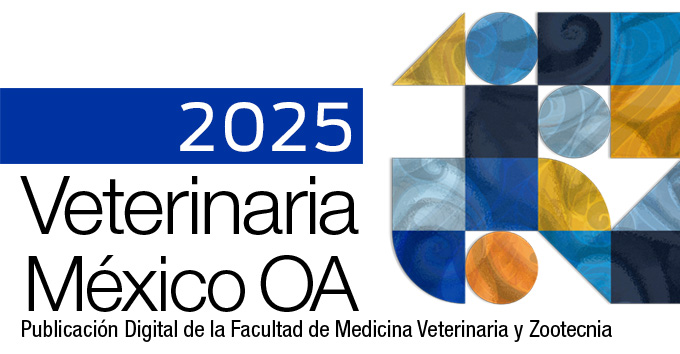Clinical assessment of Elymus repens (couch grass) as antiurolithiatic in dogs
Main Article Content
Abstract
The use of Elymus repens-based extracts as an antiurolithiatic agent in humans has been widely reported. However, in veterinary medicine, this possibility has not been explored, therefore, the objective of this study was to assess the effectiveness of a liquid formula for oral administration containing Elymus repens (commonly known as couch grass) as an antiurolithiatic in dogs. To carry out this assessment, we required dogs with a urolithiasis diagnosis, and they were divided into two groups: the control group (CG), which received a treatment without an active ingredient, and the treatment group (EG), which received treatment with the extract of Elymus repens. Both groups received the treatment for 21 days. The assessment of the treatment was performed through blood count and biochemistry. At the end of the treatment, the values observed in analytes related to urolithiasis remained unchanged in the EG group. Conversely, some analytes in CG showed changes from the beginning of the study. According to the results obtained, the treatment with the extract of Elymus repens demonstrated the expected antiurolithiatic effect. However, further complementary studies to confirm its therapeutic activity. Nonetheless, it can be considered as a possible alternative treatment for dogs.
Article Details
References
Osborne CA, Lulich JP, Polzin DJ, Sanderson SL, Koehler LA, Ulrich LK, et al. Analysis of 77,000 canine uroliths: perspectives from the Minnesota Urolith Center Veterinary Clinics of North America: Small Animal Practice. 1999;29(1):17–38. doi: 10.1016/S0195-5616(99)50002-8.
Bartges JW, Callens AJ. Urolithiasis. Veterinary Clinics of North America: Small Animal Practice. 201;45(4):747–768. doi: 10.1016/j.cvsm.2015.03.001.
Koehler LA, Osborne CA, Buettner MT, Lulich JP, Behnke R. Canine uroliths: frequently asked questions and their answers. Veterinary Clinics of North America: Small Animal Practice. 2009;39(1):161–181. doi: 10.1016/j.cvsm.2008.09.007.
Bartges JW, Osborne CA, Lulich JP, Kirk C, Allen TA, Brown C. Methods for evaluating treatment of uroliths. Veterinary Clinics of North America: Small Animal Practice. 1999;29(1):45–57. doi: 10.1016/S0195-5616(99)50004-1.
Karadi RV, Gadge NB, Alagawadi KR, Savadi RV. Effect of Moringa oleifera Lam. root-wood on ethylene glycol induced urolithiasis in rats. Journal of Ethnopharmacology. 2006;105(1–2):306–311. doi: 10.1016/j.jep.2005.11.004
Bartges JW, Finco DR, Polzin DJ, Osborne CA, Barsanti JA, Brown SA. Pathophysiology of urethral obstruction. Veterinary Clinics of North America: Small Animal Practice. 1996;26(2):255–264. doi: 10.1016/S0195-5616(96)50206-8.
McLoughlin MA. Complications of lower urinary tract surgery in small animals. Veterinary Clinics of North America: Small Animal Practice. 2011;41(5):889–913. doi: 10.1016/j.cvsm.2011.07.001.
Prasad KVSRG, Sujatha D, Bharathi K. Herbal drugs in urolithiasis - a review. Pharmacognosy Reviews. 2007;1(1):175–179.
Grases F, Ramis M, Costa-Bauzá A, March JG. Effect of Herniaria hirsuta and Agropyron repens on calcium oxalate urolithiasis risk in rats. Journal of Ethnopharmacology. 1995;45(3):211–214. doi: 10.1016/0378-8741(94)01218-O.
Widy-Tyszkiewicz E. Assessment report on Agropyron repens (L.) P. Beauv., rhizoma. European Medicines Agency. 2011. https://www.ema.europa.eu/en/documents/herbal-monograph/european-union-herbal-monograph-agropyron-repens-l-p-beauv-rhizoma-revision-1_en.pdf
Bortolami M, Di Matteo P, Rocco D, Feroci M, Petrucci R. Metabolic profile of Agropyron repens (L.) P. Beauv. rhizome herbal tea by HPLC-PDA-ESI-MS/MS analysis. molecules. 2022;27(15):4962. doi: 10.3390/molecules27154962.
Deveci E, Tel Çayan G, Karakurt S, Duru ME. Antioxidant, cytotoxic, and enzyme inhibitory activities of Agropyron repens and Crataegus monogyna species. European Journal of Biology. 2020;79(2):98–105. doi: 10.26650/EurJBiol.2020.0077.
Chamorro MMA, Collado SAV, Márquez D. Effectiveness of using Renalof® in the elimination of kidney stones under 10 mm located in the renal-ureteral tract. Open Journal of Nephrology. 2021;11:78–92. doi: 10.4236/ojneph.2021.111007.
Swapan KM, Shivaraju S, Amitha BS, Kalaiselvan E, Mamta M, Wahengbam P, et al. Surgical management of obstructive urolithiasis in a dog. Archives of Veterinary and Animal Sciences. 2020;2(2):1–4.
Martiarena B, Castillo V, Regonat M, Quintana H, Brandi G, Lamarca G, et al. Determinación de parámetros para la evaluación del metabolismo Fósforo/Cálcico en perros adultos normales. InVet. 2014;16(2):57–61.
Prajapati A, Verma RK. Laboratory diagnosis and clinical biochemistry in animals. New Delhi, India: Daya Publishing House; 2016. 210 pp.
Bawari S, Sah AN, Tewari D. Urolithiasis: An update on diagnostic modalities and treatment protocols. Indian Journal of Pharmaceutical Sciences. 2017;79(2):164–174. doi: 10.4172/pharmaceutical-sciences.1000214.
Beydokthi SS, Sendker J, Brandt S, Hensel A. Traditionally used medicinal plants against uncomplicated urinary tract infections: Hexadecyl coumaric acid ester from the rhizomes of Agropyron repens (L.) P. Beauv. with antiadhesive activity against uropathogenic E. coli. Fitoterapia. 2017;117:22–27. doi: 10.1016/j.fitote.2016.12.010.
Ríos C. Manual de patología clínica en animales de compañía. Santiago, Chile: Ril editores; 2019. 470 pp.
License

Veterinaria México OA by Facultad de Medicina Veterinaria y Zootecnia - Universidad Nacional Autónoma de México is licensed under a Creative Commons Attribution 4.0 International Licence.
Based on a work at http://www.revistas.unam.mx
- All articles in Veterinaria México OA re published under the Creative Commons Attribution 4.0 Unported (CC-BY 4.0). With this license, authors retain copyright but allow any user to share, copy, distribute, transmit, adapt and make commercial use of the work, without needing to provide additional permission as long as appropriate attribution is made to the original author or source.
- By using this license, all Veterinaria México OAarticles meet or exceed all funder and institutional requirements for being considered Open Access.
- Authors cannot use copyrighted material within their article unless that material has also been made available under a similarly liberal license.



